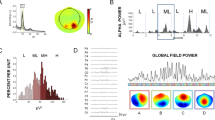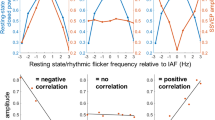Abstract
The present research aims to show that the occurrence of alpha blocking or event-related desynchronization (ERD) strongly depends on the amplitude and also on the phase angle of alpha activity at the stimulus onset. Simple visual stimulation was presented to 17 healthy subjects during EEG recording. An O2 electrode was used for analysis with a 32 channel EEG sampling system. We used a segmentation of raw data in order to obtain the evoked potential. Prestimulus and poststimulus activities were filtered in the alpha (8–13 Hz) frequency band. Later, four different events (blocked, time-locked, phase-locked, and eliminated) were separately averaged. Phase-locked sweeps were determined by application of inter-trial coherence analysis. The evaluation of the data shows that “time-locked and phase-locked sweeps” were the dominating pattern and not “the blocked pattern”, which occurred only when the prestimulus alpha was high. In the analyses of EEG-EP sweeps, only 22 % of epochs showed (ERD). The ANOVA revealed significant differences between four different alpha responses (F(3,48) = 11.175; p < 0.001). Furthermore, alpha oscillations in time-locked responses were significantly higher than blocked (p < 0.0001). The analyses clearly demonstrate that important precaution is needed when using the ERD as a cognitive or pathological marker.







Similar content being viewed by others
References
Anderson J, Rennie C, Gordon E, Howson A, Meares R (1991) Measurement of maximum variability within event-related potentials in schizophrenia. Psychiatry Res 39:33–44
Barry RJ, Kirkaikul S, Hodder D (2000) EEG alpha activity and the ERP to target stimuli in an auditory oddball paradigm. Int J Psychophysiol 39:39–50
Barry RJ, De Pascalis V, Hodder D, Clarke AR, Johnstone SJ (2003) Preferred EEG brain states at stimulus onset in a fixed interstimulus interval auditory oddball task and their effects on ERP components. Int J Psychophysiol 47(3):187–198
Barry RJ, Clarke AR, Mc Carthy R, Selikowitz M, Johnstone SJ, Rushby JA (2004) Age and gender effects in EEG coherence. I. Developmental trends in normal children. Clin Neurophysiol 115:2252–2258
Barry RJ, Rushby JA, Smith JL, Clarke AR, Croft RJ (2006) Dynamics of narrow-band EEG phase effects in the passive auditory oddball task. Eur J Neurosci 24(1):291–304
Başar E (1980) EEG–brain dynamics. Relation between EEG and brain evoked potentials. Elsevier, Amsterdam, p 412
Başar E (2011) Brain–body–mind in the nebulous cartesian system: a holistic approach by oscillations. Springer, New York
Başar E (2012) A review of alpha activity in integrative brain function: fundamental physiology, sensory coding, cognition and pathology. Int J Psychophysiol 86(1):1–24
Başar E, Güntekin B (2012) A short review of alpha activity in cognitive processes and in cognitive impairment. Int J Psychophysiol 86:25–38
Başar E, Schürmann M (1994) Functional aspects of evoked alpha and theta responses in humans and cats: occipital recordings in cross-modality experiments. Biol Cybern 72:175–183
Başar E, Stampfer HG (1985) Important associations among EEG-dynamics, eventrelated potentials, short-term memory and learning. Int J Neurosci 26(3–4):161–180
Basar E, Schürmann M, Basar-Eroglu C, Karakas S (1997) Alpha oscillations in brain functioning: an integrative theory. In: Basar E, Hari R, Lopes da Silva FH, Schürmann M (eds) Brain alpha activity: new aspects and functional correlates. special issue of the International Journal Psychophysiology, vol 26(1–3), pp 5–29
Başar E, Güntekin B, Tülay E, Yener GG (2010) Evoked and event related coherence of Alzheimer patients manifest differentiation of sensory-cognitive networks. Brain Res 1357:79–90
Becker R, Ritter P, Villringer A (2008) Influence of ongoing alpha rhythm on the visual evoked potential. NeuroImage 39:707–716
Ben-Simon E, Podlipsky I, Arieli A, Zhdanov A, Hendler T (2008) Never resting brain: simultaneous representation of two alpha related processes in humans. PLoS One 3(12):3984
Bishop PO, Jeremy D, McLeod JG (1953) Phenomenon of repetitive firing in lateral geniculate of cat. J Neurophysiol 16:443–447
Brandt J (1997) Visual and auditory evoked phase resetting of the alpha EEG. Int J Psychophysiol 26:285–298
Brandt ME, Jansen BH (1991) The relationship between prestimulus alpha amplitude and visual evoked potential amplitude. Int J Neurosci 61:261–268
Creutzfeldt OD (1993) Cortex cerebri. Performance, Structural and Functional Organization of the Cortex. Springer, Berlin
Delorme A, Makeig S (2004) EEGLAB: an open source toolbox for analysis of single-trial EEG dynamics including independent component analysis. J Neurosci Methods 134:9–21
Dinse HR, Krüger K, Mallot HP, Best J (1991) Temporal structure of cortical information processing: cortical architecture, oscillations, and non-separability of spatiotemporal receptive field organization. In: Kruger J (ed) Neuronal cooperativity. Springer, Berlin, pp 67–104
Dinse HR, Krüger K, Akhavan AC, Spengler F, Schöner G, Schreiner CE (1997) Low frequency oscillations of visual, auditory and somatosensory cortical neurons evoked by sensory stimulation. Int J Psychophysiol 26:205–227
Dudkin KN, Glezer VD, Gauselman VE, Panin AI (1978) Types of receptive fields in the lateral geniculate body and their functional model. Biol Cybern 29:37–47
Ford J, White P, Lim K, Pfefferbaum A (1994) Schizophrenics have fewer and smaller P300s: a single-trial analysis. Biol Psychiatry 35:96–103
Greenhouse SW, Geisser S (1959) On methods in the analysis of profile data. Psy-chometrika 24:95–112
Harris JB (2003) Differential conditioning of alpha amplitude: a fresh look at an old phenomenon. Clin Neurophysiol 116(6):1433–1443
Ishii R, Canuet L, Herdman A, Gunji A, Iwase M, Takahashi H, Nakahachi T, Hirata M, Robinson SE, Pantev C, Takeda M (2009) Cortical oscillatory power changes during auditory oddball task revealed by spatially filtered magnetoencephalography. Clin Neurophysiol 120(3):497–504
Jansen BH, Brandt ME (1991) The effect of phase of prestimulus alpha activity on the averaged visual evoked response. Electroencephalogr Clin Neurophysiol 80:241–250
Jasiukaitis P, Hakerem G (1998) The effect of prestimulus alpha activity on the P300. Psychophysiology 25:157–165
Klimesch W (1999) EEG alpha and theta oscillations reflect cognitive and memory performance: a review and analysis. Brain Res Rev 29:169–195
Klimesch W, Sauseng P, Hanslmayr S (2007) EEG alpha oscillations: the inhibitiontiming hypothesis. Brain Res Rev 53(1):63–88
Min BK, Herrmann CS (2007) Prestimulus EEG alpha activity reflects prestimulus top-down processing. Neurosci Lett 422(2):131–135
Pfurtscheller G, Lopes da Silva FH (1999) Event-related EEG/MEG synchronization and desynchronization: basic principles. Clin Neurophysiol 110(11):1842–1857
Pleydell-Pearce C (1994) DC potential correlates of attention and cognitive load. Cogn Neuropsychol 11:149–166
Price G (1997) The effect of pre-stimulus alpha activity on the auditory P300 paradigm: a prospective study. Brain Topogr 9:169–176
Rahn E, Başar E (1993a) Prestimulus EEG-activity strongly influences the auditory evoked vertex responses: a new method for selective averaging. Int J Neurosci 69:207–220
Rahn E, Başar E (1993b) Enhancement of visual evoked potentials by stimulation during low prestimulus EEG stages. Int J Neurosci 72:123–136
Rémond A, Lesèvre N (1967) Variations in average visual evoked potentials as a function of the alpha rhythm phase autostimulation. EGG Clin Neurophysiol 26:42–52
Rockstroh B, Elbert T, Canavan A, Lutzenberger W, Birbaumer N (1989) Slow cortical potentials and behavior. Urban and Schwarzenberg, Munich
Schürmann M, Başar E (1994) Topography of alpha and theta oscillatory responses upon auditory and visual stimuli in humans. Biol Cybern 72:161–174
Silvanto J, Muggleton N, Vincent W (2008) State-dependency in brain stimulation studies of perception and cognition. Trends Cogn Sci 12(12):447–454
Stampfer HG, Başar E (1985) Does frequency analysis lead to better understanding of human event related potentials? Int J Neurosci 26:181–196
Tallon-Baudry C, Bertrand O, Delpuech C, Pernier J (1996) Stimulus specificity of phase-locked and non-phase-locked 40 Hz visual responses in human. J Neurosci 16:4240–4249
Walter WG (1950) Normal rhythms: their development, distribution and significance. In: Hill D, Parr G (eds) Electroencephalography. McDonald, London
Author information
Authors and Affiliations
Corresponding author
Rights and permissions
About this article
Cite this article
Başar, E., Gölbaşı, B.T. Event related desynchronization: use as a neurophysiologic marker is restricted. Cogn Neurodyn 8, 437–445 (2014). https://doi.org/10.1007/s11571-014-9301-5
Received:
Revised:
Accepted:
Published:
Issue Date:
DOI: https://doi.org/10.1007/s11571-014-9301-5




